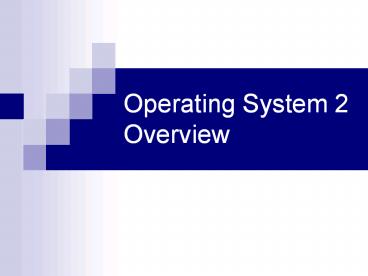Operating System 2 Overview - PowerPoint PPT Presentation
Title:
Operating System 2 Overview
Description:
Operating System 2 Overview OPERATING SYSTEM OBJECTIVES AND FUNCTIONS An OS is a program that controls the execution of application programs and acts as an interface ... – PowerPoint PPT presentation
Number of Views:150
Avg rating:3.0/5.0
Title: Operating System 2 Overview
1
Operating System 2 Overview
2
- OPERATING SYSTEM OBJECTIVES AND FUNCTIONS
3
- An OS is a program that controls the execution of
application programs and acts as an interface
between applications and the computer hardware.
Objectives - Convenience
- Efficiency
- Ability to evolve
4
- Briefly, the OS typically provides services in
the following areas - Program development
- Program execution
- Access to I/O devices
- Controlled access to files
- System access
- Error detection and response
- Accounting
5
(No Transcript)
6
(No Transcript)
7
- THE EVOLUTION OF OPERATING SYSTEMS
8
- Serial Processing
- Simple Batch Systems
- Multiprogrammed Batch Systems
- Time-Sharing Systems
9
- Serial Processing
- With the earliest computers, from the late 1940s
to the mid-1950s, the programmer interacted - directly with the computer hardware there was no
OS.These computers were run - from a console consisting of display lights,
toggle switches, some form of input device, - and a printer. Programs in machine code were
loaded via the input device (e.g., a card - reader). If an error halted the program, the
error condition was indicated by the lights. If - the program proceeded to a normal completion, the
output appeared on the printer.
10
- Simple Batch Systems
11
- Multiprogrammed batch system
12
- Time sharing
- single user was inefficient, a large group of
users together were not. - the "state" of each user and their programs would
have to be kept in the machine, and then switched
between quickly. Ex - NEW to name and begin writing a program
- OLD to retrieve a previously named program
- LIST to display the current program
- SAVE to save the current program
- RUN to execute the current program
13
(No Transcript)
14
Five major theoretical advances
- 1. Processes
- A program in execution
- An instance of a program running on a computer
- The entity that can be assigned to and executed
on a processor - A unit of activity characterized by a single
sequential thread of execution, a current state,
and an associated set of system resources - Three major lines of computer system development
created problems in timing and synchronization
that contributed to the development of the
concept of the processmultiprogramming batch
operation, time sharing, and real-time
transaction systems - problems Improper synchronization, Failed
mutual exclusion, Nondeterminate program
operation, Deadlocks
15
Five major theoretical advances
- 2. Memory management
- Process isolation
- Automatic allocation and management
- Support of modular programming
- Support of modular programming
- Long-term storage
16
(No Transcript)
17
Cont..
- 3. Information protection and security
- Availability
- Confidentiality
- Data integrity
- Authenticity
- 4. Scheduling and resource management\
- Fairness
- Differential responsiveness
- Efficiency
- 5. System structure
18
(No Transcript)
19
Different approaches on os
- Microkernel architecture
- Multithreading
- Symmetric multiprocessing
- Distributed operating systems
- Object-oriented design
20
MICROSOFT WINDOWS OVERVIEW
21
TRADITIONAL UNIX SYSTEMS
22
(No Transcript)
23
- Modern Unix Linux
24
- As UNIX evolved, the number of different
implementations proliferated, each providing
some useful features. There was a need to
produce a new implementation that unified many
of the important innovations, added other modern
OS design fetures, and produced a more modular
architecture.
25
(No Transcript)
26
(No Transcript)
27
(No Transcript)
28
(No Transcript)
29
System calls The system call is the means by
which a process requests a specific kernel
service. There are several hundred system calls,
which can be roughly grouped into six categories
filesystem, process, scheduling, interprocess
communication, socket (networking), and
miscellaneous.Table 2.7 defines a few examples in
each category.
30
System calls The system call is the means by
which a process requests a specific kernel
service. There are several hundred system calls,
which can be roughly grouped into six categories
filesystem, process, scheduling, interprocess
communication, socket (networking), and
miscellaneous.Table 2.7 defines a few examples in
each category.
31
Selesai....































